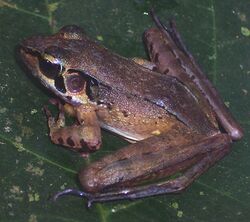Biology:Javan torrent frog
| Javan Torrent Frog | |
|---|---|

| |
| Scientific classification | |
| Domain: | Eukaryota |
| Kingdom: | Animalia |
| Phylum: | Chordata |
| Class: | Amphibia |
| Order: | Anura |
| Family: | Ranidae |
| Genus: | Huia |
| Species: | H. masonii
|
| Binomial name | |
| Huia masonii (Boulenger, 1884)
| |
| Synonyms | |
|
Rana Masonii Boulenger, 1884 | |
The Javan torrent frog (Huia masonii) is a species of frog in the family Ranidae. It is endemic to Java, Indonesia.[2] It is found in Mount Halimun Salak National Park, Ujung Kulon National Park, and Gunung Gede Pangrango National Park in West Java, as well as in Dieng Nature Reserve in Central Java.
Its natural habitats are clear, fast-flowing streams and torrents in forests and in somewhat more open areas. It is a common species within this specific habitat, which is being threatened by sedimentation of streams as well as agro-chemical pollution.[1]
Javan torrent frog males use high-frequency communication to overcome the noise of their riverine habitats that is dominated by low frequencies. The second harmonic of the calls is ultrasonic. Warbles are highly diverse and may function as vocal signatures.[3]
See also
| Wikimedia Commons has media related to Huia masonii. |
- Concave-eared Torrent Frog (Odorrana tormota), the first frog demonstrated to both produce and perceive ultrasonic frequencies
- Hole-in-the-head Frog (Huia cavitympanum), a truly ultrasonic frog
References
- ↑ 1.0 1.1 IUCN SSC Amphibian Specialist Group (2018). "Huia masonii". IUCN Red List of Threatened Species 2018: e.T58303A114920315. doi:10.2305/IUCN.UK.2018-2.RLTS.T58303A114920315.en. https://www.iucnredlist.org/species/58303/114920315. Retrieved 17 November 2021.
- ↑ Frost, Darrel R. (2014). "Huia masonii (Boulenger, 1884)". Amphibian Species of the World: an Online Reference. Version 6.0. American Museum of Natural History. http://research.amnh.org/vz/herpetology/amphibia/Amphibia/Anura/Ranidae/Huia/Huia-masonii.
- ↑ Boonman, Arjan; Kurniati, Hellen (2011). "Evolution of high-frequency communication in frogs". Evolutionary Ecology Research 13: 197–207. http://www.evolutionary-ecology.com/issues/v13/n02/iiar2625.pdf.
Wikidata ☰ Q2702565 entry


